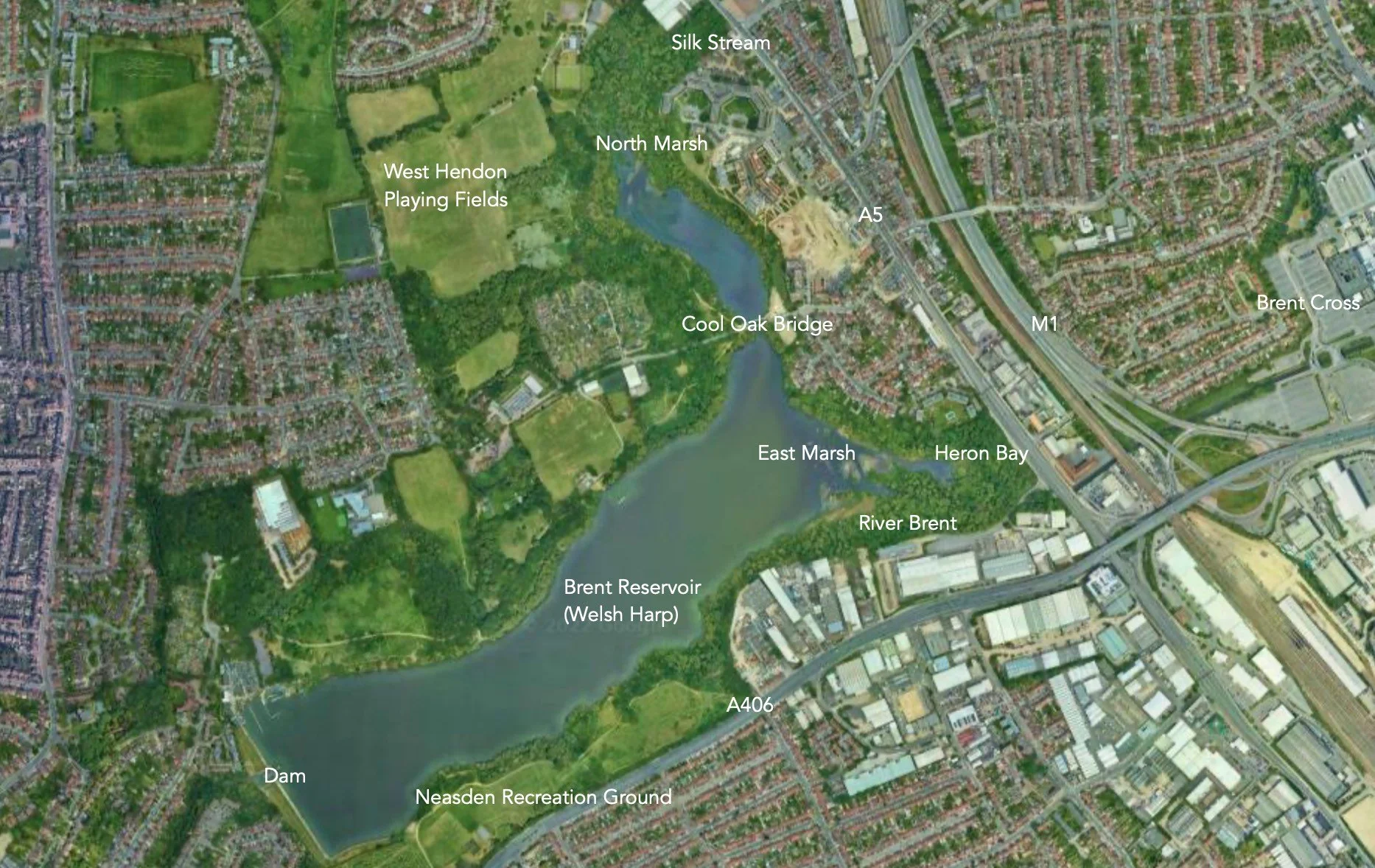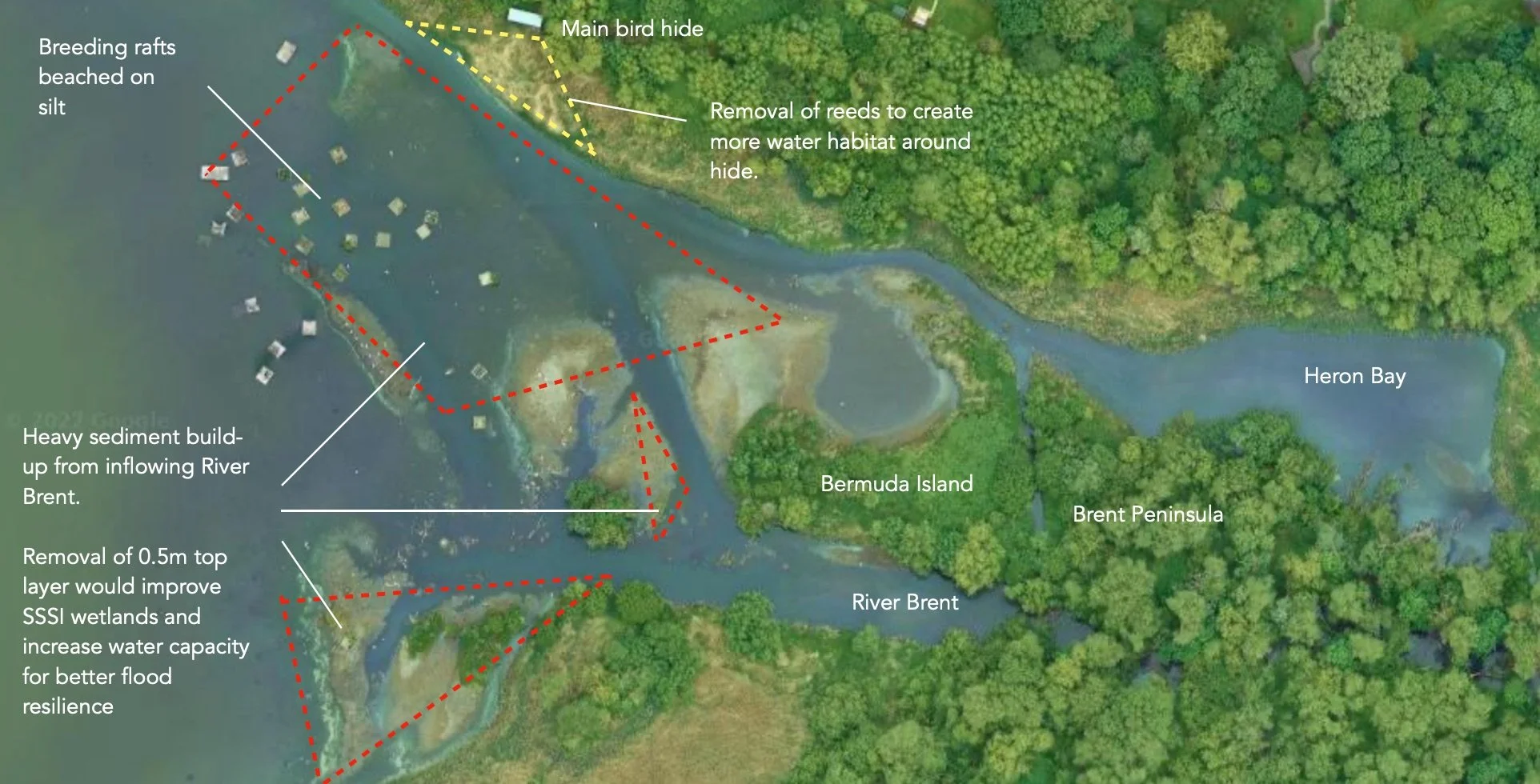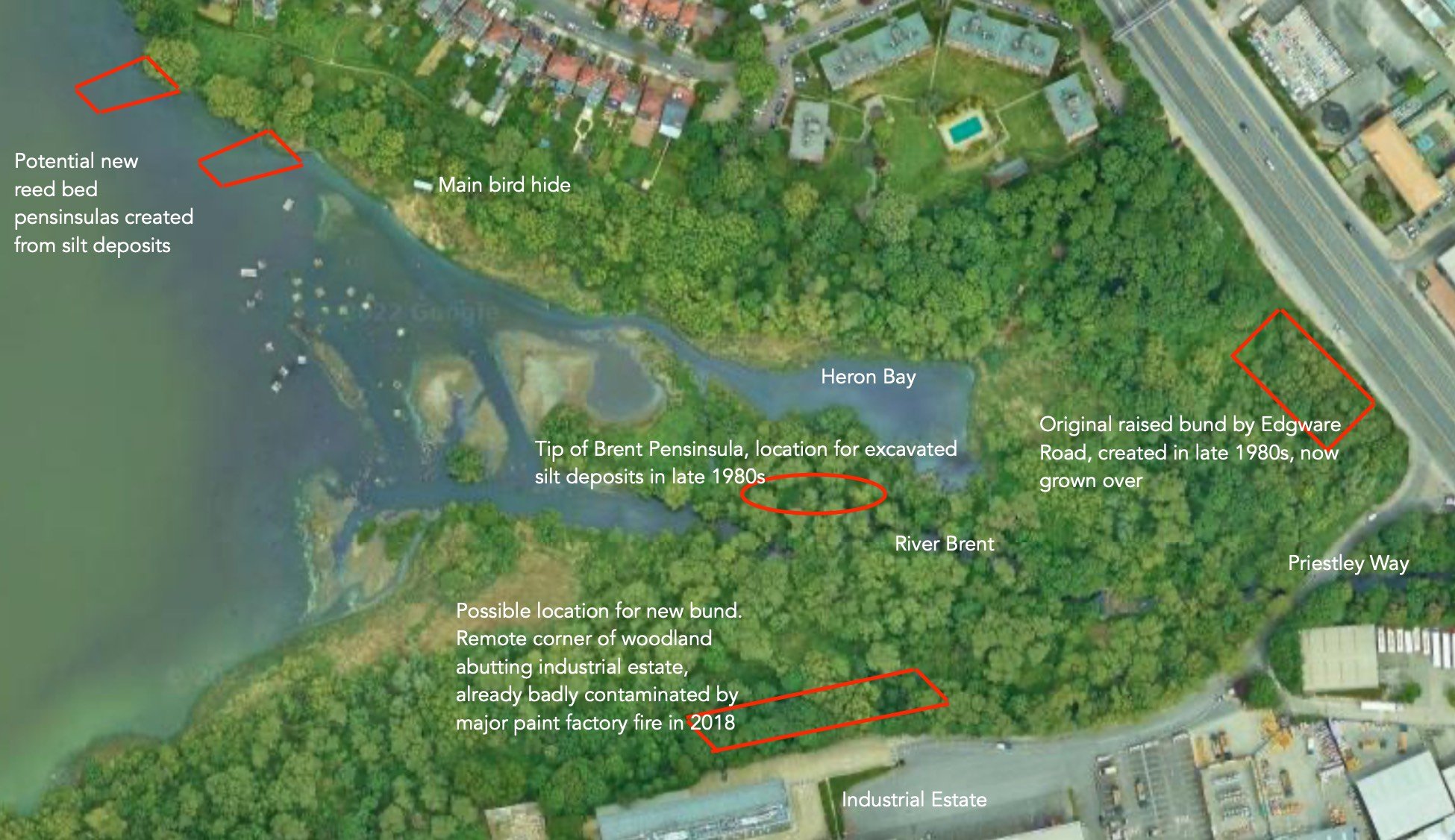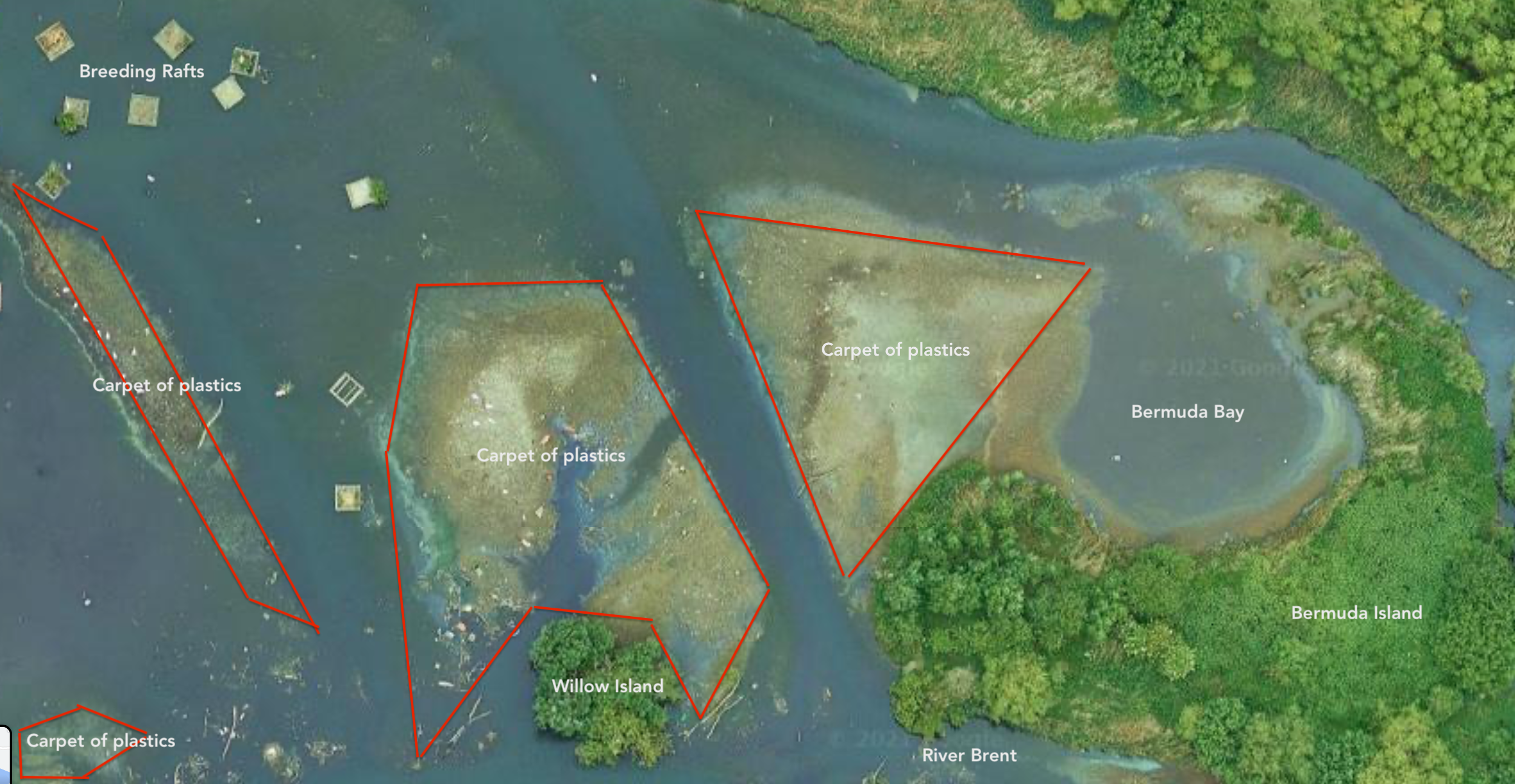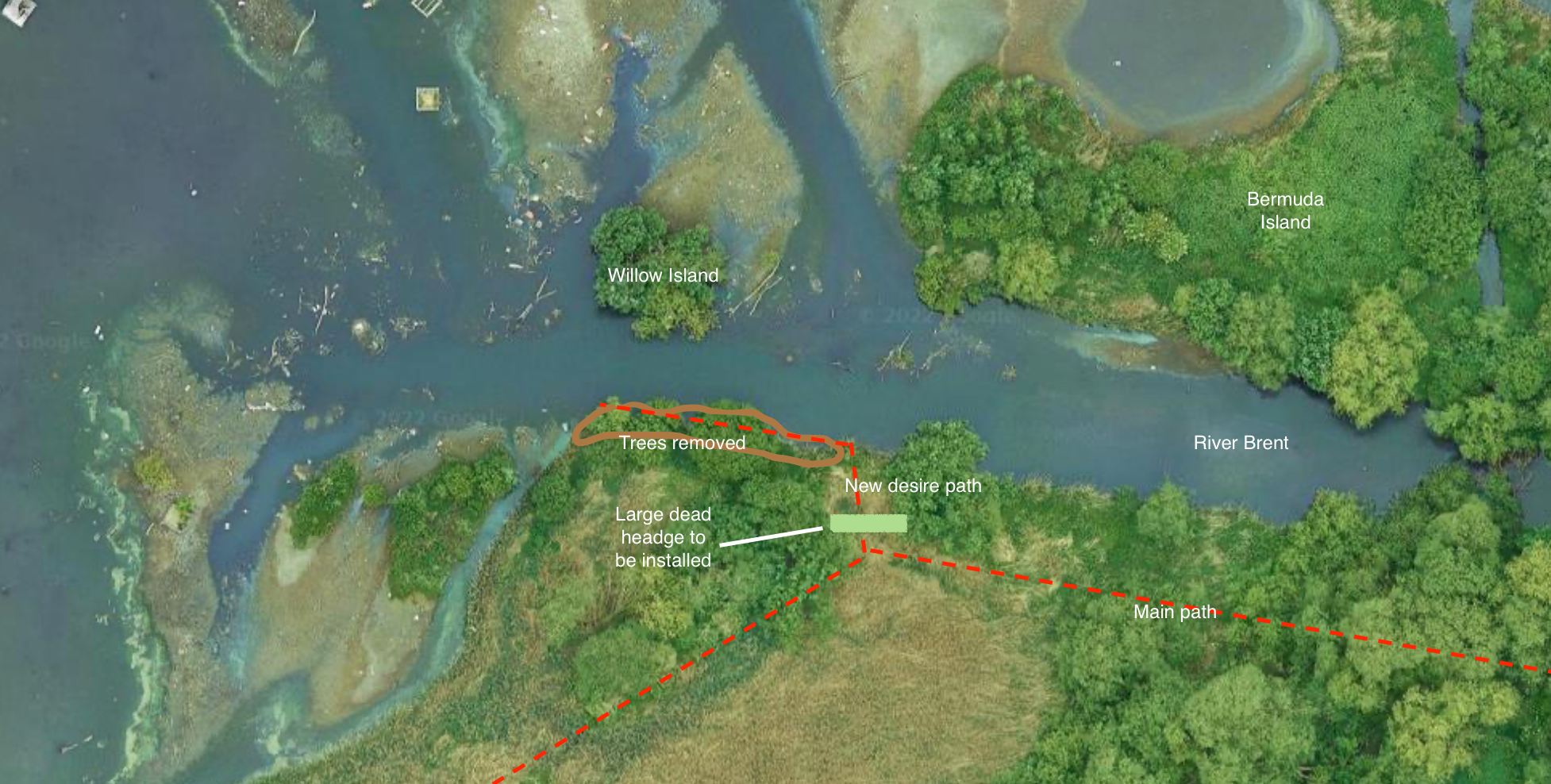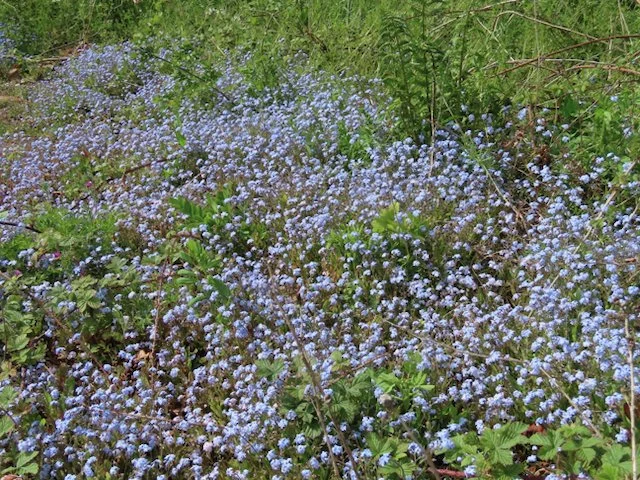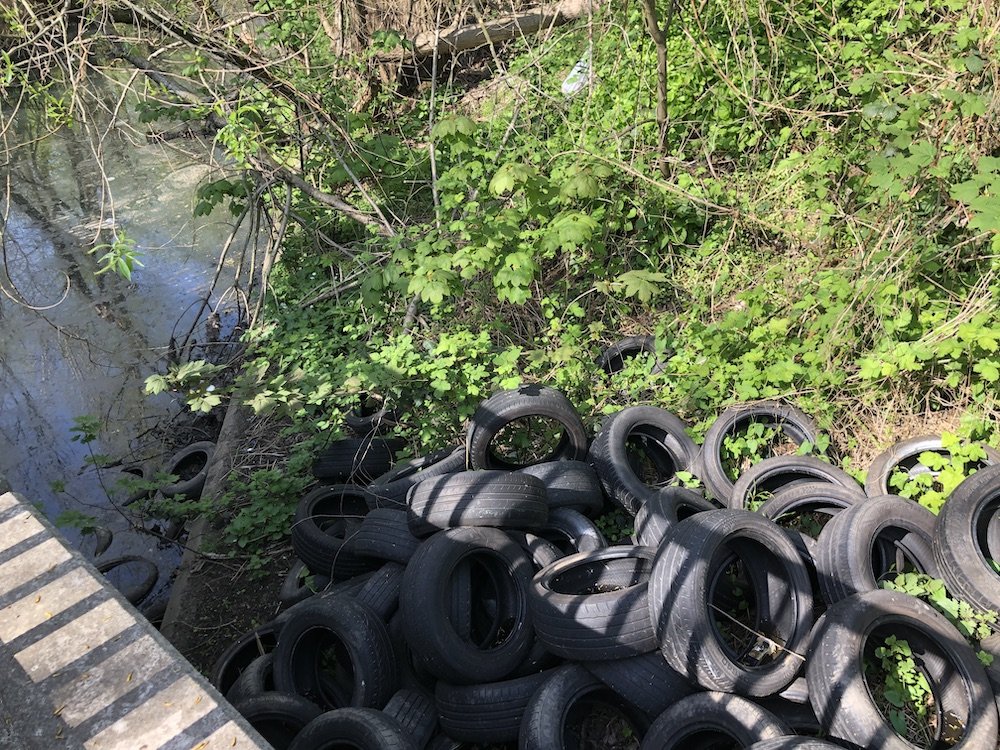
Future Habitats
Restoring Brent Reservoir SSSI
Overview
Maintaining wetlands is not just about helping wildlife and plants.
It is also about people and mental wellbeing - what we feel, on a day to day level, when we are allowed to immerse ourselves in cared-for green spaces rich in biodiversity. As many studies have shown, people simply feel good.
And in an age of rising temperatures and climate change, well-stewarded wetlands are about flood resilience and heatwave relief for nearby neighbourhoods and businesses. They act as a vital sponge in times of heavy rainfall, absorbing potential flood waters. During hot weather, they soak up urban heat, taking pressure off surrounding communities.
Building, maintaining and restoring wetlands is now known to be crucial to modern future-proof planning in densely-populated areas. And when a wetlands is also a Site of Special Scientific Interest (SSSI), there is an added imperative and legal requirement to protect and enhance it.
As one of the largest waterbodies in the capital, Brent Reservoir has a key role to play in the future health of London at many levels.
Much has been said lately about the decades of neglect it has endured. With a climate emergency recently declared in the borough by Barnet Council, there has never been a more pressing time to act. Here are some of the restoration projects and future habitats - large and small - we believe owners and managers must embrace to take Brent Reservoir forward.
East Marsh
Selective dredging
Alluvium deposits from the inflowing River Brent have drastically altered the shape of the SSSI wetlands since the last re-profiling in the 1980s.
Many of the existing breeding rafts are now beached on the silt, when they once floated in one metre of water. Periods of low rainfall lead to even larger areas of silt being exposed, turning the wetlands into dried-out contaminated reefs covered in plastics with little appeal for feeding birds.
Sediment build-up has also reduced the reservoir’s water capacity for flood relief. If it continues to remain unaddressed the reservoir’s role in flood resilience will almost certainly be compromised.
To improve the wetlands and general capacity, we suggest 0.5m of silt be skimmed off the areas worst affected. Pending full chemical analysis and EA approvals, it ould be moved into offshore bunds or part-redeployed on site. See suggestions below. Where silt removal is close to the shoreline, any existing reed fringes should be retained.
Where could the silt go?
Two locations already exist on the east marsh where silt has been previously deposited - a raised bund on the corner of Edgware Road (A5) and Priestley Way; and on the tip of the Brent Peninsula. Re-using them should be investigated.
An alternative would be a new narrow bund in the SE corner along the edge of the industrial estate on the southern side of the River Brent. This area is already in poor environmental health following outfall contamination from the major 2018 paint factory fire on nearby Waterloo Road. The bund could also be set far enough back from the woodland public footpath and riverbank.
Another option would be to use some of the silt deposits to create new peninsulas topped with reed beds further north on the east shore, where the water level is relatively low.
Plastic pollution
Large items of debris have already been removed manually from the east marsh wetlands by Canal and River Trust in 2021 and 2022, yet a carpet of medium-to-small size plastics - bags, sheeting, buckets, bottles - still litters the feeding grounds. This will continue to break down into micro-plastics entering the food chain with associated threats to animal and human health. Birds already sift though the debris, and bird numbers continue to fall. This is most likely due to poor water quality, contaminated silt and widespread plastics.
An annual winter programme of plastic removal is still needed until the situation is under control. A large tracked amphibious excavator with a bucket is likely to be the best method; it would be used to scrape off the plastics, dumping them into a floating hopper for removal off site. Further manual removal is possible but tricky in the treacherous silt, where many items are embedded and hard to pull out by hand.
Stopping the inflow of further plastic and debris from the River Brent is also key. This will need co-operation with Environment Agency (trash screen and outfall management) and Barnet and Brent Councils (upstream fly-tipping control).
We also propose Barnet Council install a second trash screen a little further up the River Brent, possibly near the new Brent Cross Town development. This would help reduce the amount of material arriving at the existing trash screen, and the items that get washed over and around it when the river rises after heavy rain.
Heron Bay
In the south-east corner of the reservoir, Heron Bay is a key refuge for protected bird species, while its reed beds act as a frontline filtration system on the low quality water arriving from the inflowing River Brent.
Future restoration should pick up where Canal and River Trust’s truncated winter works of February 2022 left off. This should include (1) more secluded alcoves cut into the reed beds, (2) a wedge of reeds removed from in front of the hide with a perimeter ledge for species such as water rail, (3) a large 5m channel cut right through the silt spit of Bermuda Island to encourage waterbird access, (4) ponds or scrapes created on the tip of the Brent peninsula following recent tree clearance, and (5) partial infill of the channel between the peninsula and Bermuda Island to stop further silt ingress from the River Brent into the bay.
Brent Peninsula
Tree removal in January 2022 at the tip of the Brent Peninsula has attracted dog walkers and members of the public, who follow the path from the trash screen to this sensitive area for breeding birds.
Extending the existing partial channel from Heron Bay to the River Brent would effectively turn the peninsula into a protected island, dissuading visitors. A narrow weir board or metal insert could be placed across the channel to stop the flow of silt from the river to the bay. This work could be achieved manually with a big-enough team, if no amphibious excavator were available.
Dead hedge on southern shore
Tree removal on the southern shore has opened up a new desire path for the public in an area sensitive for breeding birds. Illegal anglers have already been approached by EA officers in this area. Waterbirds have been harassed from the shoreline by members of the public.
A large dead-hedge is recommended to prevent further access.
North Marsh
Restored North Western Wetlands
In the late 1980s, public money was spent extensively re-profiling the upper reaches of the north marsh at the top of the northern arm of Brent Reservoir to create a mosaic of habitats suitable for the breeding birds protected under the SSSI citation of 1950 (renewed in 1985). A large area of overgrown vegetation and accumulated river silt from the inflowing Silk Stream was reclaimed, and secluded islands, canals and backwaters were created.
Sadly, through neglect and lack of funds for adequate stewardship, these remarkable wetlands - in spite of their protected SSSI status - have been allowed to fall into disrepair over the thirty years since. Breeding birds have left, and a monoculture of wet woodland, dominated by willow, bramble, invasives and plastic pollution has taken over.
To make matters worse ecologically, planning permission for a new 186m pedestrian footbridge passing right through the wetlands was granted in 2018. Designed to link new housing with nearby playing fields, it will - if built - remove any chance of the area around it being meaningfully restored. The full story of its impact is told here.
New questions about the bridge were raised by Cool Oak in 2021. With the project now under fresh review by the council, we propose a partial reclamation of the wetlands away from the affected area. This would be a dynamic first step towards a full restoration of the entire wetlands - to include the relocation of the bridge - in due course.
The revived ‘North-Western Wetlands’ would make use of the skeleton of canals and channels still locatable from the 1980s works, and excavate a fresh series of interlinked pools and ponds. Silt and soil could be dumped at the foot of the adjoining high embankment, with human activity on the path above remaining well screened.
Breeding birds protected under the SSSI citation could return, and a new green space rich in biodiversity would be created.
Siltation, dredging, flood relief and plastic pollution
Sediment and plastics from the inflowing Silk Stream have impacted heavily on the north marsh over the past thirty years.
Not only have channels cut from the riverbank into the original 1980s wetlands transported silt and debris into the upper section compromising the SSSI habitat, but a large delta of sediment has settled at the mouth of the stream in the shallow open water.
The result has been similar to the issues facing the east marsh habitats - low water quality, unhealthy feeding grounds, large areas of dried-out contaminated reef in periods of low rainfall, a carpet of plastics, and reduced reservoir capacity for flood relief.
A new selective dredging initiative in this area is vital for the area to sustain protected bird numbers and increase biodiversity and flood resilience.
An old existing bund - now overgrown - west of the proposed North Western Wetlands project could perhaps be re-purposed for excavated silt.
Large items of plastic and debris at the mouth of the Silk Stream were removed by Canal and River Trust in March 2021, but a long-term project to remove more using a tracked amphibious excavator and hopper is also needed.
The Silk Stream channel and adjacent woodland are also heavily contaminated with plastic pollution. Some of this could be collected by hand. A ‘grab’ vehicle might be needed for large clumps of plastic trapped in the channel.
Other Projects
Plant Map
None of the three owners of Brent Reservoir have a current inventory of plants growing at the Welsh Harp. This means rare plants noted in the SSSI citation are going unprotected, and invasive species such as giant hogweed and Himalayan balsam are making dangerous inroads.
Cool Oak has unearthed the last plant inventory drawn up almost thirty years ago in 1994, and created a new digital database.
We urge owners to use this as the basis of a new citizen-science-led project to re-map the flora of the Welsh Harp to better manage and protect biodiversity.
Stop fly-tipping
Fly-tipping remains a constant threat to Brent Reservoir. Hazardous materials such as asbestos are left on verges, tyres are unloaded onto riverbanks. Plastic pollution is rife in many places.
We urge owners to (1) find solutions to local dumping in known kerbside hotspots, (2) tackle riverbank dumping further upstream, and (3) consider clean-up partnerships with local businesses and retail parks adjoining the Welsh Harp’s green spaces.

